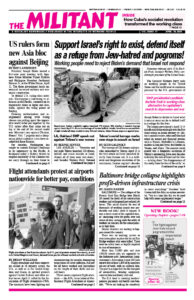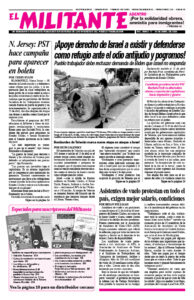BALTIMORE — The collapse of the Francis Scott Key Bridge here March 26 caused the death of six construction workers and widespread port-related job losses. This social disaster for tens of thousands of working people was predictable and didn’t need to happen. It was a direct result of the capitalist bosses’ unceasing drive for profit, over and above all else, casting aside the safety of workers or concern for the consequences to their lives.
Similar disasters are waiting to happen around the country.
There was no warning system or evacuation plans in place for the six Key Bridge workers who were killed. There were no safety boats as legally required in case of emergency.
More than 15,000 jobs and over 139,000 related jobs are supported by the Baltimore port. International Longshoremen’s Association Local 333 here reports that at least 1,800 of its members are out of work, with no callback date. The port is a major hub for the transport of automobiles, farming equipment, construction machinery and coal.
The ILA local is covering workers’ pension payments and health care benefits. “We’re not looking for somebody to cover everything” President Scott Cowan told the Afro, an online newsletter, “but at a time like this we do need help with some supplemental wages.”
This is an important demand the labor movement should take up. Millions of working people need a government-guaranteed supplemental income for their families so they can keep working.
The factors that led to the Key Bridge collapsing from the strike by the container ship Dali aren’t unique. They’re found in bridges across the country.
Twenty-six barges loaded with coal broke loose on the Ohio River in Pittsburgh April 13. Drifting miles downstream as flood waters were rising, six went over the Emsworth Dam. The McKees Rocks Bridge was shut down due to the risk that the barges would hit and damage it. A close call.
The relentless drive for profits is why shipping magnates build ever-larger container vessels, and port bosses hurry to compete for their expanding business by dredging in harbors and under bridges that are not prepared for their size. Even with its massive size, the Dali is not one of the largest container ships on the seas. Some are nearly twice as big.
In 2016 the Panama Canal was expanded to allow passage of the larger container ships, and port bosses — like in Baltimore — hurried to dredge deeper channels to compete for their business. This made the long trip up the Chesapeake Bay more worthwhile to ship owners.
The port installed four massive new cranes to handle the increase in traffic from the bigger ships. But even after the dredging, the depth of the channel reached only 50 feet. The hull of a ship like the Dali has only two feet of clearance from the river bottom. Complicating matters, a high-pressure natural gas line runs across the channel floor.
In another sign of the callous disregard by the owners and the government, the 21 crew members are still on board the Dali, which is encased in a twisted web of metal and broken roadway from the bridge.
FBI agents raided the ship April 15. Maryland Gov. Wes Moore praised their efforts, saying discovering who there was responsible for the accident would bring closure to the families of workers who died on the bridge. But what the FBI is really doing is looking for a worker to frame up, letting the bosses off the hook.
New disasters waiting to happen
The American Society of Civil Engineers and the federal government report 46,000 bridges across the country are aging and in poor condition. They say 17,000 are at risk of collapse from a single hit by a boat.
Over 300 major bridges in the U.S. have bridge foundations that are inadequate or deteriorating. A review in the New York Times found 193 bridges, each one of which carries 10,000 vehicles or more a day, have no protections for the piers at their base. The Times details “catastrophic failures” on bridges in Tampa Bay, Florida; Mobile, Alabama; South Padre Island, Texas; and Webbers Falls, Oklahoma.

